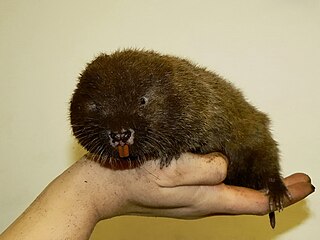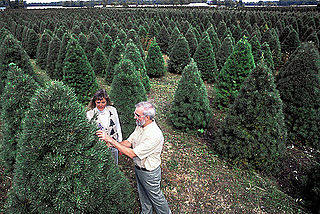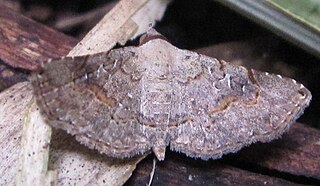
Moths are a paraphyletic group of insects that includes all members of the order Lepidoptera that are not butterflies, with moths making up the vast majority of the order. There are thought to be approximately 160,000 species of moth, many of which have yet to be described. Most species of moth are nocturnal, but there are also crepuscular and diurnal species.
Forest integrated pest management or Forest IPM is the practice of monitoring and managing pest and environmental information with pest control methods to prevent pest damage to forests and forest habitats by the most economical means. Forest IPM practices vary from region to region and particularly by state, according to the habitat and forests present. Forest integrated pest management or Forest IPM combines cultural, biological and chemical technologies to reduce pest damage to levels below those that of economic damage. Forest IPM is utilized for the whole life of the tree, from site prep to harvest. An IPM treatment is utilized before the cost of the treatment is equal to the reduction in crop value due to past injury, which is called the economic injury level. Forest integrated pest management has a strong emphasis on intensive forest management.

The lesser bamboo rat is a species of rodent in the family Spalacidae. It is monotypic within the genus Cannomys. It is found in Bangladesh, Bhutan, Cambodia, China, India, Myanmar, Nepal, and Thailand.

Pine and fir trees, grown purposely for use as Christmas trees, are vulnerable to a wide variety of pests, weeds and diseases. Many of the conifer species cultivated face infestations and death from such pests as the balsam woolly adelgid and other adelgids. Aphids are another common insect pest. Christmas trees are also vulnerable to fungal pathogens and their resultant illnesses such as root rot, and, in the U.S. state of California, sudden oak death. Douglas-fir trees in particular are vulnerable to infections from plant pathogens such as R. pseudotsugae.

Ascotis selenaria, the giant looper, is a moth of the family Geometridae. The species was first described by Michael Denis and Ignaz Schiffermüller in 1775.

Mythimna separata, the northern armyworm, oriental armyworm or rice ear-cutting caterpillar, is a moth of the family Noctuidae. It is found in China, Japan, South-east Asia, India, eastern Australia, New Zealand, and some Pacific islands. It is one of the major pests of maize in Asia. The species was first described by Francis Walker in 1865.
Crypsiptya is a genus of moths of the family Crambidae.

Gypsonoma aceriana, the poplar shoot-borer, is a moth of the family Tortricidae. It is found from Europe to Russia, eastern Turkey and Iraq. It is also present in North Africa.

Pyralis pictalis, the painted meal moth or poplar pyralis, is a snout moth. It is closely related to the family's type species the meal moth and consequently belongs to the tribe Pyralini of the snout moth subfamily Pyralinae. Its native range is tropical Asia to East Asia and to Wallacea and adjacent regions, but it has been quite widely distributed by humans. The term "Poplar" in its common name does not refer to the trees, but to Poplar, London, where the type specimen – from such an introduction – was caught. It was called scarce meal moth in the original description, which is only correct for the fringes of its range however.

Spodoptera mauritia, the lawn armyworm or paddy swarming caterpillar, is a moth of the family Noctuidae. The species was first described by Jean Baptiste Boisduval in 1833. Able to eat many types of food, it is a major pest throughout the world.

Scirpophaga incertulas, the yellow stem borer or rice yellow stem borer, is a species of moth of the family Crambidae. It was described by Francis Walker in 1863. It is found in Afghanistan, Nepal, north-eastern India, Sri Lanka, Bangladesh, Myanmar, Vietnam, Thailand, Malaysia, Singapore, Sumatra, Java, Borneo, Sumba, Sulawesi, the Philippines, Taiwan, China and Japan.

Arctornis submarginata is a species of moth of the subfamily Lymantriinae of family Erebidae. It is found in the north-eastern Himalaya and Sikkim, Sri Lanka, on Borneo and Sumatra and in northern Australia.

Rhesala moestalis is a species of moth of the family Erebidae first described by Francis Walker in 1866. It is found throughout subtropical Africa, from Sierra Leone in the west to Somalia in the east and South Africa in the south. It is also found on most of the African Indian Ocean islands. and in South and South-East Asia.

Somena scintillans, the yellow tail tussock moth, is a moth in the family Erebidae described by Francis Walker in 1856. It is found in northern India, Sri Lanka, Myanmar and the Andaman Islands. Though considered a minor pest, larva can sporadically be a serious pest.

Glyphodes pyloalis, the lesser mulberry snout moth, lesser mulberry pyralid or beautiful glyphodes moth, is a moth in the family Crambidae. It was described by Francis Walker in 1859. It is found in Iran, China, Japan, India, Indonesia (Sumatra), Sri Lanka, Taiwan, the Democratic Republic of the Congo, Equatorial Guinea, Mozambique and North America, where it has been recorded from Florida, Maryland, North Carolina, South Carolina and Virginia.

Hyposidra talaca, the black looper or black inch worm, is a moth of the family Geometridae. The species was first described by Francis Walker in 1860. It is found from India to Indochina, Sundaland, Sulawesi, the Philippines, Sri Lanka, the Solomon Islands, Thailand, Taiwan, New Guinea and Australia, where it has been recorded from Queensland. It is a major defoliating pest in tea plantations.

Parasa bicolor, the green rice moth, is a moth of the family Limacodidae. The species was first described by Francis Walker in 1855. It is found in Sri Lanka, India, Nepal, Pakistan, Myanmar, Laos, Taiwan, Vietnam, Malaysia, Java, China and Taiwan.
Metisa plana is a moth of the family Psychidae first described by Francis Walker in 1883. It is found in Sumatra, Malaysia and Sri Lanka. It is a major pest on Elaeis guineensis, the African oil palm.
Pyrilla perpusilla, commonly known as the sugarcane planthopper, is a planthopper in the family Lophopidae. It is native to Asia where it feeds on grasses and other plants and is a major pest of sugarcane and sorghum.
Estigmena chinensis, commonly known as Green standing bamboo borer, is a species of leaf beetle found in India, Sri Lanka and Myanmar. It is a major pest of bamboo.















